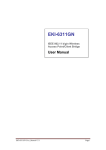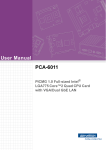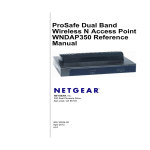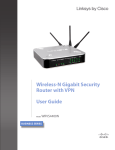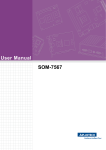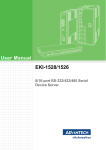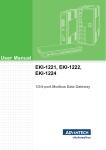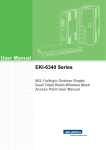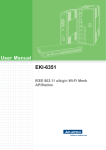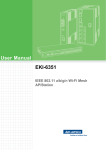Download User Manual EKI
Transcript
User Manual EKI-6310GN 2.4GHz 802.11b/g/n Outdoor AP/ CPE Copyright The documentation and the software included with this product are copyrighted 2014 by Advantech Co., Ltd. All rights are reserved. Advantech Co., Ltd. reserves the right to make improvements in the products described in this manual at any time without notice. No part of this manual may be reproduced, copied, translated or transmitted in any form or by any means without the prior written permission of Advantech Co., Ltd. Information provided in this manual is intended to be accurate and reliable. However, Advantech Co., Ltd. assumes no responsibility for its use, nor for any infringements of the rights of third parties, which may result from its use. Acknowledgements Microsoft Windows and MS-DOS are registered trademarks of Microsoft Corp. All other product names or trademarks are properties of their respective owners. Product Warranty (5 years) Advantech warrants to you, the original purchaser, that each of its products will be free from defects in materials and workmanship for five years from the date of purchase. This warranty does not apply to any products which have been repaired or altered by persons other than repair personnel authorized by Advantech, or which have been subject to misuse, abuse, accident or improper installation. Advantech assumes no liability under the terms of this warranty as a consequence of such events. Because of Advantech’s high quality-control standards and rigorous testing, most of our customers never need to use our repair service. If an Advantech product is defective, it will be repaired or replaced at no charge during the warranty period. For outof-warranty repairs, you will be billed according to the cost of replacement materials, service time and freight. Please consult your dealer for more details. If you think you have a defective product, follow these steps: 1. Collect all the information about the problem encountered. (For example, CPU speed, Advantech products used, other hardware and software used, etc.) Note anything abnormal and list any onscreen messages you get when the problem occurs. 2. Call your dealer and describe the problem. Please have your manual, product, and any helpful information readily available. 3. If your product is diagnosed as defective, obtain an RMA (return merchandize authorization) number from your dealer. This allows us to process your return more quickly. 4. Carefully pack the defective product, a fully-completed Repair and Replacement Order Card and a photocopy proof of purchase date (such as your sales receipt) in a shippable container. A product returned without proof of the purchase date is not eligible for warranty service. 5. Write the RMA number visibly on the outside of the package and ship it prepaid to your dealer. EKI-6310GN User Manual Part No. 2063634000 Edition 1 Printed in Taiwan May 2014 ii Declaration of Conformity FCC Class A Note: This equipment has been tested and found to comply with the limits for a Class A digital device, pursuant to part 15 of the FCC Rules. These limits are designed to provide reasonable protection against harmful interference when the equipment is operated in a commercial environment. This equipment generates, uses, and can radiate radio frequency energy and, if not installed and used in accordance with the instruction manual, may cause harmful interference to radio communications. Operation of this equipment in a residential area is likely to cause harmful interference in which case the user will be required to correct the interference at his own expense. FCC Class B This equipment has been tested and found to comply with the limits for a Class B digital device, pursuant to part 15 of the FCC Rules. These limits are designed to provide reasonable protection against harmful interference in a residential installation. This equipment generates, uses and can radiate radio frequency energy and, if not installed and used in accordance with the instructions, may cause harmful interference to radio communications. However, there is no guarantee that interference will not occur in a particular installation. If this equipment does cause harmful interference to radio or television reception, which can be determined by turning the equipment off and on, the user is encouraged to try to correct the interference by one or more of the following measures: Reorient or relocate the receiving antenna. Increase the separation between the equipment and receiver. Connect the equipment into an outlet on a circuit different from that to which the receiver is connected. Consult the dealer or an experienced radio/TV technician for help. iii EKI-6310GN User Manual Technical Support and Assistance 1. 2. Visit the Advantech web site at www.advantech.com/support where you can find the latest information about the product. Contact your distributor, sales representative, or Advantech's customer service center for technical support if you need additional assistance. Please have the following information ready before you call: – Product name and serial number – Description of your peripheral attachments – Description of your software (operating system, version, application software, etc.) – A complete description of the problem – The exact wording of any error messages Warnings, Cautions and Notes Warning! Warnings indicate conditions, which if not observed, can cause personal injury! Caution! Cautions are included to help you avoid damaging hardware or losing data. e.g. There is a danger of a new battery exploding if it is incorrectly installed. Do not attempt to recharge, force open, or heat the battery. Replace the battery only with the same or equivalent type recommended by the manufacturer. Discard used batteries according to the manufacturer's instructions. Note! Notes provide optional additional information. Document Feedback To assist us in making improvements to this manual, we would welcome comments and constructive criticism. Please send all such - in writing to: [email protected] EKI-6310GN User Manual iv Safety Instructions 1. 2. 3. Read these safety instructions carefully. Keep this User Manual for later reference. Disconnect this equipment from any AC outlet before cleaning. Use a damp cloth. Do not use liquid or spray detergents for cleaning. 4. For plug-in equipment, the power outlet socket must be located near the equipment and must be easily accessible. 5. Keep this equipment away from humidity. 6. Put this equipment on a reliable surface during installation. Dropping it or letting it fall may cause damage. 7. The openings on the enclosure are for air convection. Protect the equipment from overheating. DO NOT COVER THE OPENINGS. 8. Make sure the voltage of the power source is correct before connecting the equipment to the power outlet. 9. Position the power cord so that people cannot step on it. Do not place anything over the power cord. 10. All cautions and warnings on the equipment should be noted. 11. If the equipment is not used for a long time, disconnect it from the power source to avoid damage by transient overvoltage. 12. Never pour any liquid into an opening. This may cause fire or electrical shock. 13. Never open the equipment. For safety reasons, the equipment should be opened only by qualified service personnel. 14. If one of the following situations arises, get the equipment checked by service personnel: The power cord or plug is damaged. Liquid has penetrated into the equipment. The equipment has been exposed to moisture. The equipment does not work well, or you cannot get it to work according to the user's manual. The equipment has been dropped and damaged. The equipment has obvious signs of breakage. 15. DO NOT LEAVE THIS EQUIPMENT IN AN ENVIRONMENT WHERE THE STORAGE TEMPERATURE MAY GO BELOW -40° C (-4° F) OR ABOVE 85° C (185° F). THIS COULD DAMAGE THE EQUIPMENT. THE EQUIPMENT SHOULD BE IN A CONTROLLED ENVIRONMENT. 16. CAUTION: DANGER OF EXPLOSION IF BATTERY IS INCORRECTLY REPLACED. REPLACE ONLY WITH THE SAME OR EQUIVALENT TYPE RECOMMENDED BY THE MANUFACTURER, DISCARD USED BATTERIES ACCORDING TO THE MANUFACTURER'S INSTRUCTIONS. The sound pressure level at the operator's position according to IEC 704-1:1982 is no more than 70 dB (A). DISCLAIMER: This set of instructions is given according to IEC 704-1. Advantech disclaims all responsibility for the accuracy of any statements contained herein. v EKI-6310GN User Manual Safety Precaution - Static Electricity Follow these simple precautions to protect yourself from harm and the products from damage. To avoid electrical shock, always disconnect the power from your PC chassis before you work on it. Don't touch any components on the CPU card or other cards while the PC is on. Disconnect power before making any configuration changes. The sudden rush of power as you connect a jumper or install a card may damage sensitive electronic components. Professional Installation Required Please seek assistance from a professional installer who is well trained in the RF installation and knowledgeable in the local regulations. Precautions 1. To keep you safe and install the hardware properly, please read and follow these safety precautions. 2. If you are installing EKI-6310GN for the first time, for your safety as well as others', please seek assistance from a professional installer who has received safety training on the hazards involved. 3. Keep safety as well as performance in mind when selecting your installation site, especially where there are electric power and phone lines. 4. When installing EKI-6310GN, please note the following things: – Do not use a metal ladder; – Do not work on a wet or windy day; – Wear shoes with rubber soles and heels, rubber gloves, long sleeved shirt or jacket. 5. When the system is operational, avoid standing directly in front of it. strong RF fields are present when the transmitter is on. EKI-6310GN User Manual vi Contents Chapter Chapter Chapter 1 Overview...............................................1 1.1 1.2 1.3 1.4 Introduction ............................................................................................... 2 Features .................................................................................................... 2 Specification.............................................................................................. 2 Packing List............................................................................................... 3 2 Installation............................................5 2.1 2.2 2.3 2.4 Preparation before Installation .................................................................. 6 Installation Precautions ............................................................................. 6 Hardware Installation ................................................................................ 7 Pole Mounting ........................................................................................... 7 3 Basic Settings ......................................9 3.1 3.4 Factory Default Settings.......................................................................... 10 Table 3.1: EKI-6310GN Factory Default Settings...................... 10 System Requirements............................................................................. 11 How to Login the Web-based Interface................................................... 11 Figure 3.1 Login Page ............................................................... 11 Figure 3.2 Main Page ................................................................ 11 Basic Setting Scenario ............................................................................ 12 Figure 3.3 Operation mode........................................................ 12 Figure 3.4 Network Settings ...................................................... 13 Figure 3.5 WAN Settings ........................................................... 13 Figure 3.6 LAN Setting .............................................................. 13 Figure 3.7 Basic Wireless Access Point Settings ...................... 14 Figure 3.8 Basic Wireless Client Settings.................................. 15 4 Network Settings ...............................17 4.1 Router ..................................................................................................... 18 4.1.1 WAN............................................................................................ 18 Figure 4.1 WAN Settings ........................................................... 18 Figure 4.2 Static Fixed IP Settings ............................................ 19 Figure 4.3 Cable/Dynamic IP Settings....................................... 19 Figure 4.4 PPPoE Settings ........................................................ 20 Figure 4.5 PPTP Settings .......................................................... 21 Figure 4.6 L2TP Settings ........................................................... 22 4.1.2 LAN ............................................................................................. 23 Figure 4.7 LAN Settings in router .............................................. 23 4.1.3 IPV6 ............................................................................................ 24 Figure 4.8 IPv6 Settings ............................................................ 24 Figure 4.9 Static Fixed IPv6 Settings......................................... 24 Figure 4.10SLAAC Settings........................................................ 25 Figure 4.11DHCPv6 Settings...................................................... 26 Figure 4.126to4 Tunnel Settings................................................. 27 Figure 4.136in4 Tunnel Settings................................................. 28 Figure 4.14IPv6 PPPoE Settings................................................ 29 Figure 4.15IPv6 Pass Through Settings ..................................... 30 4.1.4 Advanced Routing....................................................................... 30 Figure 4.16Advanced Routing .................................................... 30 3.2 3.3 Chapter vii EKI-6310GN User Manual 4.1.5 Chapter 4.2 DHCP STATIC LEASED (STATIC DHCP) ................................. 31 Figure 4.17Static DHCP ............................................................. 31 Bridge...................................................................................................... 31 4.2.1 LAN............................................................................................. 31 Figure 4.18LAN Settings in router .............................................. 31 5 Wireless Access Point Settings ...... 33 5.1 Access Point ........................................................................................... 34 5.1.1 Basic Wireless Settings .............................................................. 34 Figure 5.1 Basic Wireless Settings in AP mode ........................ 34 5.1.2 SSID Security Settings ............................................................... 35 Figure 5.2 Security settings ....................................................... 35 Figure 5.3 WEP Encryption ....................................................... 35 Figure 5.4 WPA Encryption ....................................................... 36 Figure 5.5 WPA-PSK Encryption............................................... 37 Figure 5.6 WPA2 Encryption ..................................................... 37 Figure 5.7 WPA2-PSK Encryption............................................. 38 Figure 5.8 WPA-AUTO Encryption ............................................ 38 Figure 5.9 WPA-PSK-AUTO Encryption.................................... 39 Figure 5.10802.1x Encryption..................................................... 39 Figure 5.11WPS Setting ............................................................. 40 WDS Access Point.................................................................................. 40 5.2.1 Basic Wireless Settings .............................................................. 41 Figure 5.12Basic Wireless Settings in WDS AP mode............... 41 5.2.2 SSID SECURITY SETTINGS ..................................................... 42 Figure 5.13Security settings ....................................................... 42 Figure 5.14WEP Encryption ....................................................... 42 Figure 5.15WPA Encryption ....................................................... 43 Figure 5.16WPA-PSK Encryption............................................... 44 Figure 5.17WPA2 Encryption ..................................................... 44 Figure 5.18WPA2-PSK Encryption............................................. 45 Figure 5.19WPA-AUTO Encryption ............................................ 45 Figure 5.20WPA-PSK-AUTO Encryption.................................... 46 Figure 5.21Figure 45 802.1x Encryption .................................... 46 Figure 5.22WPS Setting ............................................................. 47 WDS Repeater........................................................................................ 47 5.3.1 BASIC WIRELESS SETTINGS .................................................. 48 Figure 5.23Basic Wireless Settings in WDS Repeater mode..... 48 5.3.2 SSID I / SSID II SECURITY SETTINGS..................................... 49 Figure 5.24Security settings ....................................................... 49 5.2 5.3 Chapter Chapter 6 Wireless Client Settings ................... 51 6.1 Client / WDS Client ................................................................................. 52 Figure 6.1 Client Profile settings................................................ 52 Figure 6.2 AP Selection in Site Survey...................................... 53 Figure 6.3 Profile Setup............................................................. 53 Figure 6.4 ACK Timeout Setting................................................ 54 7 Advanced Settings............................ 55 7.1 Management ........................................................................................... 56 Figure 7.1 Management Setting ................................................ 56 Figure 7.2 Web Interface Setting............................................... 56 Figure 7.3 Firmware Upgrade Setting ....................................... 57 Figure 7.4 Configuration Setting................................................ 57 Figure 7.5 Load Factory Defaults Setting .................................. 57 EKI-6310GN User Manual viii 7.2 7.3 7.4 Chapter 8 8.1 8.2 8.3 8.4 8.5 Figure 7.6 Reboot Setting.......................................................... 58 Figure 7.7 Scheduling Reset Setting ......................................... 58 Advanced Setting .................................................................................... 58 Figure 7.8 Advanced Setting ..................................................... 58 Figure 7.9 System Time Setting ................................................ 59 Figure 7.10DDNS Setting ........................................................... 59 Figure 7.11SNMP Setting ........................................................... 60 Figure 7.12Telnet/SSH Setting ................................................... 60 System Log ............................................................................................. 61 Figure 7.13System Log............................................................... 61 Tools ....................................................................................................... 61 Figure 7.14Ping Tool .................................................................. 62 Figure 7.15Trace Route tool ....................................................... 62 Figure 7.16Throughput tool ........................................................ 63 Application Rules And Firewall ........65 Figure 8.1 Rules & Firewall........................................................ 66 MAC/Port/IP Filtering .............................................................................. 66 Figure 8.2 MAC/IP/Port Filter..................................................... 66 Virtual Server .......................................................................................... 67 Figure 8.3 Virtual Server............................................................ 67 DMZ ........................................................................................................ 68 Figure 8.4 DMZ.......................................................................... 68 Firewall.................................................................................................... 68 Figure 8.5 Firewall ..................................................................... 68 Content Filter........................................................................................... 69 Figure 8.6 URL filter................................................................... 69 Figure 8.7 Host filter .................................................................. 70 Appendix A Application Wizard ............................71 A.1 Hotspot.................................................................................................... 72 Figure A.1 WiFi Hotspot ............................................................. 72 Intranet Coverage ................................................................................... 74 Figure A.2 Intranet coverage...................................................... 74 Repeater ................................................................................................. 78 Figure A.3 Repeater usage ........................................................ 78 Long Distance Point-to-point................................................................... 83 Figure A.4 Long distance Transition .......................................... 83 Fast Roaming.......................................................................................... 88 Figure A.5 AGV - Fast Roaming ................................................ 88 A.2 A.3 A.4 A.5 ix EKI-6310GN User Manual EKI-6310GN User Manual x Chapter 1 Overview 1 1.1 Introduction EKI-6310GN is a feature rich wireless AP/ CPE which provides a reliable wireless connectivity for industrial environments. The PoE helps to connect to PoE switch directly. As an 802.11n compliant device, EKI-6310GN provides 3 times higher data rates than legacy 802.11g devices. EKI-6310GN effectively improves the reliability of wireless connectivity, especially in applications that need high reliability and high throughput data transmission. To secure wireless connections, EKI-6310GN encrypts data through 64/128/152-bit WEP data encryption and also supports WPA2/WPA/ 802.1x for powerful security authentication. 1.2 Features Compliant with IEEE 802.11b/g and IEEE 802.11n Support Standard Power-over-Ethernet (PoE) IP66 waterproof certification Four operating modes including AP, Wireless Client, WDS and WDS AP Repeater Support 64/128/152-bit WEP and 802.1X, WPA, WPA2, WPA&WPA2,WPAPSK, WPA2-PSK, and WPA-PSK&WPA2-PSK etc User-friendly Web and SNMP-based management interface With external N-type connector for optional antenna (default 5 dBi Omni antenna) Support distances up to 5Km 1.3 Specification Standard Support Wireless: IEEE802.11b/g/n Ethernet: IEEE802.3u MDI / MDIX 10/100 Fast Ethernet LAN: IEEE802.11b/g/n wireless LAN interface Data Rates – 802.11b 11, 5.5, 2, 1 Mbps, auto-fallback – 802.11g 54, 48, 36, 24, 18, 12, 9, 6 Mbps, auto-fallback – 802.11n 6M, 6.5M, 13M, 13.5M, 19.5M, 26M, 27M, 39M,40.5M, 53M, 54M, 58.5M, 65M, 78M, 81M, 104M,108M, 117M, 121.5M, 130M, 135M, 150Mbps Physical Specifications Power: 802.3af PoE Dimensions (L x W x H): 228 x 64 x 61 mm Weight: 500g Antenna: Antenna Configuration 1x1 ( 1 Tx, 1 Rx) Reserve N-type Connector (Plug) with 5dBi dipole antenna for indoor AP application. EKI-6310GN User Manual 2 Overview Channel Support 802.11b/g/n HT20 FCC: CH1 ~ CH11; ETSI: CH1 ~ CH13 802.11gn HT40 FCC: CH3 ~ CH9; ETSI: CH3 ~ CH11 Wireless Transmission Rates Transmitted Power 802.11b: 26dBm 802.11g: 26dBm @ 6Mbps, 24dBm @ 54Mbps 802.11gn HT20: 26dBm @ MCS0, 22dBm@ MCS7 802.11gn HT40: 26dBm @ MCS0, 21dBm@ MCS7 Receiver Sensitivity 802.11b: -93dBm @ 1Mbps; -88dBm @ 11Mbps 802.11g: -89dBm @ 6Mbps; -73dBm @ 54Mbps 802.11n HT20: -88dBm @ MCS0; -70dBm @ MCS7 802.11n HT40: -84dBm @ MCS0; -67dBm @ MCS7 1.4 Packing List The product package you have received should contain the following items. If any of them are not included or damaged, please contact your local vendor for support. EKI-6310GN ×1 Pole Mounting Ring ×1 PoE Adapter ×1 Start up manual ×1 User's manual CD ×1 RSMA Omni antenna ×1 3 Chapter 1 Modulation Techniques 802.11b DSSS (DBPSK, DQPSK, CCK) 802.11g OFDM, DSSS (BPSK, QPSK, 16-QAM, 64-QAM) 802.11n OFDM (BPSK, QPSK, 16-QAM, 64-QAM) EKI-6310GN User Manual EKI-6310GN User Manual 4 Chapter 2 Installation 2 This chapter describes safety precautions and product information you have to know and check before installing EKI-6310GN. 2.1 Preparation before Installation Professional Installation Required Please seek assistance from a professional installer who is well trained in the RF installation and knowledgeable in the local regulations. Safety Precautions 1. To keep you safe and install the hardware properly, please read and follow these safety precautions. 2. 2. If you are installing EKI-6310GN for the first time, for your safety as well as others’, please seek assistance from a professional installer who has received safety training on the hazards involved. 3. Keep safety as well as performance in mind when selecting your installation site, especially where there are electric power and phone lines. 4. When installing EKI-6310GN, please note the following things: Do not use a metal ladder; Do not work on a wet or windy day; Wear shoes with rubber soles and heels, rubber gloves, long sleeved shirt or jacket. 5. When the system is operational, avoid standing directly in front of it. Strong RF fields are present when the transmitter is on. 2.2 Installation Precautions To keep the EKI-6310GN well while you are installing it, please read and follow these installation precautions. 1. Users MUST use a proper and well-installed surge arrestor with the EKI6310GN; otherwise, a random lightening could easily cause fatal damage to EKI-6310GN. EMD (Lightning) DAMAGE IS NOT COVERED UNDER WARRNTY. 2. Users MUST use the “Power cord & PoE Injector” shipped in the box with the EKI-6310GN. Use of other options will cause damage to the EKI-6310GN. 3. Users MUST power off the EKI-6310GN first before connecting the external antenna to it. Do not switch from built-in antenna to the external antenna from WEB management without physically attaching the external antenna onto the EKI-6310GN; otherwise, damage might be caused to the EKI-6310GN itself. EKI-6310GN User Manual 6 Connect up 1. The bottom of the EKI-6310GN is a movable cover. Grab the cover and pull it back harder to take it out as the figure shown below. 2. Plug a standard Ethernet cable into the RJ45 port. 3. Slide the cover back to seal the bottom of the EKI-6310GN. Connect up 1. Turn the EKI-6310GN over. Put the pole mounting ring through the middle hole of it. Note that you should unlock the pole mounting ring with a screw driver before putting it through EKI-6310GN as the following right picture shows. 2. Mount EKI-6310GN steadily to the pole by locking the pole mounting ring tightly. 3. Now you have completed the hardware installation of EKI-6310GN. Using the External Antenna Grab the black rubber on the top of EKI-6310GN, and slightly pull it up. The metal N-type connector will appear. Connect your antenna on the top of EKI-6310GN. The following picture shows the full set of EKI-6310GN: 7 EKI-6310GN User Manual Installation 2.4 Pole Mounting Chapter 2 2.3 Hardware Installation EKI-6310GN User Manual 8 Chapter 3 Basic Settings 3 3.1 Factory Default Settings We’ll elaborate the EKI-6310GN factory default settings. You can re-acquire these parameters by default. If necessary, please refer to the “Restore Factory Default Settings”. Table 3.1: EKI-6310GN Factory Default Settings Features Factory Default Settings Username admin Password admin Operation Mode AP Bridge LAN IP Adress 192.168.2.1 Subnet Mask 255.255.255.0 Default Gateway Primary DNS Secondary DNS MTU WLAN 1500 Spanning Tree Disable DHCP Server Disable Country Code United States Wireless mode Access Point Network Name (SSID) EKI-6310GN Frequency (Channel) Channel 6 Network Mode WiFi 11gn HT20 Encryption Setting Disable (Open) Distance 0.6mi BG Protection Mode Disable Access Control Disable Advanced Package Aggregate Enable WMM Enable TX Power 23 dBm Beacon Interval 100 ms DTIM 1 Threshold SNMP Telnet / SSH RTS/CTS Disable Fragmentation Threshold Disable Station Control 127 Wireless Isolation Disable LED1 -94 LED2 -80 LED3 -73 LED4 -65 Enable/Disable Disable Read Community Name Public Write Community Name Private IP Address 0.0.0.0 Telnet Enable SSH Disable Username root Password Advantech EKI-6310GN User Manual 10 Before configuration, please make sure your system meets the following requirements: A computer coupled with 10/ 100 Base-TX adapter; Configure the computer with a static IP address of 192.168.2.x, as the default IP address of EKI-6310GN is 192.168.2.1. (X cannot be 0, 1, nor 255); A Web browser on PC for configuration such as Microsoft Internet Explorer 6.0 or above, Netscape, Firefox or Google Chrome. Open Web browser and enter the IP address (Default: 192.168.2.1) of EKI6310GN into the address field. You will see the login page as below. Figure 3.1 Login Page Enter the username (Default: admin) and password (Default: admin) respectively and click "Login" to login the main page of EKI-6310GN. As you can see, this management interface provides three main options in the gray bar above, which are Status, Advanced and Language. Most functions are configured in 'Advanced' option. Figure 3.2 Main Page 11 EKI-6310GN User Manual Basic Settings 3.3 How to Login the Web-based Interface Chapter 3 3.2 System Requirements 3.4 Basic Setting Scenario You can configure your devices to different roles in following scenario. Configure 'operation mode' of your device. You can configure EKI-6310GN as four different modes - AP Router (router connection), AP Bridge (access point), Client Router (WISP - wireless Internet Service Provider) and Client Bridge (WiFi client). Figure 3.3 Operation mode Configure your network setting in 'WAN' and 'LAN' options. It will provide you the configuration of LAN or WAN based on bridge or router mode. The default IP of WAN and LAN is fixed IP '192.168.2.1' (WAN) & '192.168.1.1' (LAN) when you select router mode. EKI-6310GN User Manual 12 Chapter 3 Basic Settings Figure 3.4 Network Settings Figure 3.5 WAN Settings Figure 3.6 LAN Setting 13 EKI-6310GN User Manual Please configure your wireless access point setting in 'Basic' options if you use as access point. Please configure your wireless client setting in 'Basic' options if you use as client. Figure 3.7 Basic Wireless Access Point Settings EKI-6310GN User Manual 14 Chapter 3 Basic Settings Figure 3.8 Basic Wireless Client Settings 15 EKI-6310GN User Manual EKI-6310GN User Manual 16 Chapter 4 Network Settings 4 4.1 Router You can configure the WAN and LAN in your network settings when you use EKI6310GN as router. In router usage, the Ethernet LAN port will be your WAN interface and wireless LAN will be your LAN interface. EKI-6310GN supports IPv4 or IPv6 in WAN to access the internet. If you use IPv6 in Internet access, please follow the Chapter 4.1.3 to configure your WAN network setting. Otherwise, you can refer to Chapter 4.1.1 to configure your WAN. Note! The Ethernet port will convert into WAN port requiring you to configure your CPE via WLAN if you configure EKI-6310GN through Ethernet port in the beginning. 4.1.1 WAN You can have five types of WAN connection, including of Static Fixed IP, Cable/ Dynamic IP(DHCP), PPPoE(ADSL), PPTP and L2TP. Figure 4.1 WAN Settings Static Fixed IP Select Static (Fixed IP), if your Internet service provider (ISP) to be permanent address on the Internet. A Static IP address is a number (in the form of a dotted quad). Users must enter WAN IP address, Subnet Mask, Gateway setting or DNS settings provided by your ISPs. EKI-6310GN User Manual 18 Chapter 4 Cable/Dynamic IP Select Cable/Dynamic IP (DHCP), if your Internet service provider (ISP) uses a DHCP service to assign your Router an IP address when you connect to the Internet. Figure 4.3 Cable/Dynamic IP Settings MTU: Maximum transmission unit (MTU) is the largest protocol data unit that the layer can pass onwards. You need to configure this parameter based on your networking. 19 EKI-6310GN User Manual Network Settings Figure 4.2 Static Fixed IP Settings MTU: Maximum transmission unit (MTU) is the largest protocol data unit that the layer can pass onwards. You need to configure this parameter based on your networking. IP Address: Sets the static IP address. Subnet Mask: Sets the static IP subnet mask. (Default: 255.255.255.0) Default Gateway: The IP address of a router that is used when the requested destination IP address is not on the local subnet. Primary DNS Server: The IP address of the Primary Domain Name Server. A DNS maps numerical IP addresses to domain names and can be used to identify network hosts by familiar names instead of the IP addresses. To specify a DNS server, type the IP addresses in the text field provided. Otherwise, leave the text field blank. Secondary DNS Server: The IP address of the Secondary Domain Name Server. Hostname: The name of the host on the network providing the IP address Primary DNS Server: The IP address of the Primary Domain Name Server. A DNS maps numerical IP addresses to domain names and can be used to identify network hosts by familiar names instead of the IP addresses. To specify a DNS server, type the IP addresses in the text field provided. Otherwise, leave the text field blank. Secondary DNS Server: The IP address of the Secondary Domain Name Server. PPPoE Select PPPoE to be assigned automatically from an Internet service provider (ISP) through a DSL modem using Point-to-Point Protocol over Ethernet (PPPoE). Figure 4.4 PPPoE Settings MTU: Maximum transmission unit (MTU) is the largest protocol data unit that the layer can pass onwards. You need to configure this parameter based on your networking. Username: Sets the PPPoE dial-in user name for the WAN port. Password: Sets a PPPoE dial-in password for the WAN port. Verify Password: Double-confirm the password you key-in in password field. Operation mode: Enables and configures the keep alive time. Keep Alive Mode: Setup the timer. After the timer, PPPoE will re-dial again. Primary DNS Server: The IP address of the Primary Domain Name Server. A DNS maps numerical IP addresses to domain names and can be used to identify network hosts by familiar names instead of the IP addresses. To specify a DNS server, type the IP addresses in the text field provided. Otherwise, leave the text field blank. Secondary DNS Server: The IP address of the Secondary Domain Name Server. EKI-6310GN User Manual 20 PPTP Select PPTP, if you are using PPTP service to gain connection to the Internet. 21 EKI-6310GN User Manual Network Settings Figure 4.5 PPTP Settings MTU: Maximum transmission unit (MTU) is the largest protocol data unit that the layer can pass onwards. You need to configure this parameter based on your networking. Server IP: Sets the PPTP server IP Address. (Default: pptp_server) Username: Sets the PPTP user name for the WAN port. Password: Sets a PPTP password for the WAN port. Address Mode: Sets a PPTP network mode. (Default: Static IP) IP Address: Sets the static IP address. Subnet Mask: Sets the static IP subnet mask. (Default: 255.255.255.0) Operation mode: Enables and configures the keep alive time. Keep Alive Mode: Setup the timer. After the timer, PPTP will re-connect again. Primary DNS Server: The IP address of the Primary Domain Name Server. A DNS maps numerical IP addresses to domain names and can be used to identify network hosts by familiar names instead of the IP addresses. To specify a DNS server, type the IP addresses in the text field provided. Otherwise, leave the text field blank. Secondary DNS Server: The IP address of the Secondary Domain Name Server. Chapter 4 L2TP Select L2TP, if you are using PPTP service to gain connection to the Internet. Figure 4.6 L2TP Settings MTU: Maximum transmission unit (MTU) is the largest protocol data unit that the layer can pass onwards. You need to configure this parameter based on your networking. Server IP: Sets the L2TP server IP Address. (Default: l2tp_server) Username: Sets the L2TP user name for the WAN port. Password: Sets a L2TP password for the WAN port. Address Mode: Sets a L2TP network mode. (Default: Static IP) IP Address: Sets the static IP address. Subnet Mask: Sets the static IP subnet mask. (Default: 255.255.255.0) Operation mode: Enables and configures the keep alive time. Keep Alive Mode: Setup the timer. After the timer, L2TP will re-connect again. Primary DNS Server: The IP address of the Primary Domain Name Server. A DNS maps numerical IP addresses to domain names and can be used to identify network hosts by familiar names instead of the IP addresses. To specify a DNS server, type the IP addresses in the text field provided. Otherwise, leave the text field blank. Secondary DNS Server: The IP address of the Secondary Domain Name Server. EKI-6310GN User Manual 22 Chapter 4 4.1.2 LAN 23 EKI-6310GN User Manual Network Settings Figure 4.7 LAN Settings in router IP Address: Sets the static IP address for your LAN interface. Subnet Mask: Sets the static IP subnet mask. (Default: 255.255.255.0) MTU: Maximum transmission unit (MTU) is the largest protocol data unit that the layer can pass onwards. You need to configure this parameter based on your networking. Spanning Tree: Enable or Disable STP (spanning-tree protocol). Spanning Tree Protocol (STP) is a link management protocol for AP which provides path redundancy while preventing loops in a network. STP allows only one active path at a time between the access points but establish the redundant link as a backup if the initial link fails. DHCP Server: You have three options for DHCP Server configuration, including of 'Disable', 'DHCP Relay' and 'DHCP Server'. When you disable DHCP Server service, you will don't need to configuration assigned IP range. If you configure to 'DHCP Relay', you will need to configure the DHCP Relay server and your device will relay the DHCP request to DHCP server. DHCP Relay: Assign the IP of DHCP server in your network, and EKI-6310GN will forward DHCP request to DHCP server that you assign. Local Domain Name: Optional, you can enter local domain name for your network Start IP Address: Starting IP Address for the server's IP assignment End IP Address: Ending IP Address for the server's IP assignment Lease Time: The time period for the IP address lease 4.1.3 IPV6 You can have seven types of IPv6 Internet connection, including of Static Fixed IPv6, SLAAC, DHCPv6, 6in4 Tunnel, 6to4 Tunnel, IPV6 PPPoE and IPv6 pass through. Figure 4.8 IPv6 Settings Static Fixed IPv6 Select Static (Fixed IP), if your ISP provides you with a set IPv6 addresses that does not change. The IPv6 information is manually entered in your IPv6 configuration settings. Figure 4.9 Static Fixed IPv6 Settings IPv6 Address: Enter the WAN IPv6 address for the router here. Subnet Prefix Length: Enter the WAN subnet prefix length value used here IPv6 Default Gateway: Enter the WAN default gateway IPv6 address used here. IPV6 Primary DNS Server: Enter the WAN primary DNS Server address used here. IPV6 Secondary DNS Server: Enter the WAN secondary DNS Server address used here. LAN IPv6 IP Address: These are the settings of the LAN (Local Area Network) IPv6 interface for the router. The router's LAN IPv6 Address configuration is based on the IPv6 Address and Subnet assigned by your ISP. (A subnet with prefix /64 is supported in LAN.) IPV6 AutoConfiguration: EKI-6310GN autonomously configures its own LinkLocal address. Router solicitation is sent by booting nodes to request RAs for configuring the interfaces. EKI-6310GN User Manual 24 SLAAC SLAAC is IPv6 Stateless Address Auto-configuration. EKI-6310GN will use this SLAAC technology to get prefix and generate Host ID (by EUI-64 algorithm). EKI-6310GN will use those two information as IPv6 address. Network ID (Prefix): 64bits Host ID: 64bits IPv6 Address: : 25 EKI-6310GN User Manual Network Settings Figure 4.10 SLAAC Settings IPV6 Primary DNS Server: Enter the WAN primary DNS Server address used here. IPV6 Secondary DNS Server: Enter the WAN secondary DNS Server address used here. LAN IPv6 IP Address: These are the settings of the LAN (Local Area Network) IPv6 interface for the router. The router's LAN IPv6 Address configuration is based on the IPv6 Address and Subnet assigned by your ISP. (A subnet with prefix /64 is supported in LAN.) IPV6 AutoConfiguration: EKI-6310GN autonomously configures its own LinkLocal address. Router solicitation is sent by booting nodes to request RAs for configuring the interfaces. Chapter 4 DHCPv6 DHCPv6 provides a means of passing additional configuration options to nodes after they obtain their IPv6 addresses. Figure 4.11 DHCPv6 Settings IPV6 Primary DNS Server: Enter the WAN primary DNS Server address used here. IPV6 Secondary DNS Server: Enter the WAN secondary DNS Server address used here. Ebable DHCP-PD: Enable DHCP-PD Support. SLD ID: Site-Level Aggregation Identifier SLA Length: Length of site-level aggregation identifier (SLA). LAN IPv6 IP Address: These are the settings of the LAN (Local Area Network) IPv6 interface for the router. The router's LAN IPv6 Address configuration is based on the IPv6 Address and Subnet assigned by your ISP. (A subnet with prefix /64 is supported in LAN.) IPV6 AutoConfiguration: EKI-6310GN autonomously configures its own LinkLocal address. Router solicitation is sent by booting nodes to request RAs for configuring the interfaces. EKI-6310GN User Manual 26 6to4 Tunnel 6to4 tunnel is an automatic tunnel method to tunnel IPv6 packets into IPv4 packets based on RFC3056. As time progressed, implementations came about allowing the tunnel to originate and terminate directly from personal computers using the same 6to4 protocol. This means that computers that are on IPv4-only networks can talk to computers on IPv6-only networks. It is the mode of 6to4 that we will focus on here. It gives a prefix to the attached IPv6 network in 6to4 tunnel mode. Chapter 4 Network Settings Figure 4.12 6to4 Tunnel Settings IPV6 Primary DNS Server: Enter the WAN primary DNS Server address used here. IPV6 Secondary DNS Server: Enter the WAN secondary DNS Server address used here. 6to4 Relay Router: The IPv6 address of 6to4 Relay Router LAN IPv6 IP Address: These are the settings of the LAN (Local Area Network) IPv6 interface for the router. The router's LAN IPv6 Address configuration is based on the IPv6 Address and Subnet assigned by your ISP. (A subnet with prefix /64 is supported in LAN.) IPV6 AutoConfiguration: EKI-6310GN autonomously configures its own LinkLocal address. Router solicitation is sent by booting nodes to request RAs for configuring the interfaces. 27 EKI-6310GN User Manual 6in4 Tunnel IPv6 in IPv4 tunneling is an Internet transition mechanism for migrating from IPv4 to IPv6. 6in4 uses tunneling to encapsulate IPv6 traffic over explicitly configured IPv4 lines as defined in RFC 4213. Figure 4.13 6in4 Tunnel Settings Remote IPv4 Address: Remote IPv4 address for your ISP account. Remote IPv6 Address: Remote IPv6 address for your ISP account. Local IPv4 Address: Local IPv4 address for your ISP account Local IPv6 Address: Local IPv6 address for your ISP account IPV6 Primary DNS Server: Enter the WAN primary DNS Server address used here. IPV6 Secondary DNS Server: Enter the WAN secondary DNS Server address used here. LAN IPv6 IP Address: These are the settings of the LAN (Local Area Network) IPv6 interface for the router. The router's LAN IPv6 Address configuration is based on the IPv6 Address and Subnet assigned by your ISP. (A subnet with prefix /64 is supported in LAN.) IPV6 AutoConfiguration: EKI-6310GN autonomously configures its own LinkLocal address. Router solicitation is sent by booting nodes to request RAs for configuring the interfaces. EKI-6310GN User Manual 28 IPv6 PPPoE Use Point-to-Point Protocol over Ethernet (PPPoE) network protocol to dial-in ISP network. Chapter 4 Network Settings Figure 4.14 IPv6 PPPoE Settings Login: Enter your PPPoE user name. Password: Enter your PPPoE password and then retype the password in the next box. IPV6 Primary DNS Server: Enter the WAN primary DNS Server address used here. IPV6 Secondary DNS Server: Enter the WAN secondary DNS Server address used here. Ebable DHCP-PD: Enable DHCP-PD Support. SLD ID: Site-Level Aggregation Identifier SLA Length: Length of site-level aggregation identifier (SLA). LAN IPv6 IP Address: These are the settings of the LAN (Local Area Network) IPv6 interface for the router. The router's LAN IPv6 Address configuration is based on the IPv6 Address and Subnet assigned by your ISP. (A subnet with prefix /64 is supported in LAN.) IPV6 AutoConfiguration: EKI-6310GN autonomously configures its own LinkLocal address. Router solicitation is sent by booting nodes to request RAs for configuring the interfaces. 29 EKI-6310GN User Manual IPv6 Pass Through In pass-through mode, the router works as a Layer 2 Ethernet switch with two ports (LAN and WAN Ethernet ports) for IPv6 packets. The router does not process any IPv6 header packets. Figure 4.15 IPv6 Pass Through Settings 4.1.4 Advanced Routing EKI-6310GN allows you to configure advanced routing feature. Figure 4.16 Advanced Routing Destination: The IP address of packets that can be routed. Type: Defines the type of destination. (Host: Signal IP address / Net: Portion of Network) Netmask: Displays the sub network associated with the destination. Gateway: Defines the packets destination next hop. Interface: Select interface to which a static routing subnet is to be applied. Comment: Help identify the routing. RIP: Enable or disable the RIP (Routing Information Protocol) for the WAN or LAN interface EKI-6310GN User Manual 30 EKI-6310GN provides a solution to this mess: static DHCP, also known as DHCP reservation. While configuring your router for DHCP, you have the ability to enter the MAC addresses of Client and enter which IP address to assign them. EKI-6310GN will automatically take care of rest. 4.2 Bridge You can configure the LAN in your network settings when you use EKI-6310GN as bridge. 4.2.1 LAN Figure 4.18 LAN Settings in router IP Address: Sets the static IP address for your LAN interface. Subnet Mask: Sets the static IP subnet mask. (Default: 255.255.255.0) MTU: Maximum transmission unit (MTU) is the largest protocol data unit that the layer can pass onwards. You need to configure this parameter based on your networking. 31 EKI-6310GN User Manual Network Settings Figure 4.17 Static DHCP MAC Address: Enter the MAC address of client. IP Address: Assign them an IP address. You won't be able to add the same IP address to two different MAC addresses, so make sure each MAC has a unique IP. Chapter 4 4.1.5 DHCP STATIC LEASED (STATIC DHCP) Spanning Tree: Enable or Disable STP (spanning-tree protocol). The spanning-tree algorithm calculates the best loop-free path throughout a Layer 2 network. DHCP Server: You have three options for DHCP Server configuration, including of 'Disable', 'DHCP Relay' and 'DHCP Server'. When you disable DHCP Server service, you will don't need to configuration assigned IP range. If you configure to 'DHCP Relay', you will need to configure the DHCP Relay server and your device will relay the DHCP request to DHCP server. DHCP Relay: Assign the IP of DHCP server in your network, and EKI-6310GN will forward DHCP request to DHCP server that you assign. Local Domain Name: Optional, you can enter local domain name for your network Start IP Address: Starting IP Address for the server's IP assignment End IP Address: Ending IP Address for the server's IP assignment Lease Time: The time period for the IP address lease EKI-6310GN User Manual 32 Chapter 5 5 Wireless Access Point Settings This chapter describes Access Point configuration, including of Access Point, WDS Access Point and WDS Repeater. 5.1 Access Point In Access Point Mode, the EKI-6310GN connects your wireless devices together, and it also allows a connected wired device to connect to your other devices wirelessly. This can be useful if you already had an existing Internet router that does not have built-in wireless capabilities or used this to create a private wireless network without Internet access so that your devices can securely connect to one another without being exposed to the Internet or other computers. 5.1.1 Basic Wireless Settings Figure 5.1 Basic Wireless Settings in AP mode Wireless mode: You have three options (Access Point, WDS Access Point or WDS Repeater) Multiple SSID: Enable or Disable multiple SSIDs support. When you enable this option, you will have maximum two SSIDs (Configure in 'SSID I' and 'SSID II'). Country Code: The availability of some specific channels and/or operational frequency bands is country dependent. Frequency (Channel): Channel varies much as the available band differs from country to country. Select a proper operating channel in the drop-down list according to your situation. Site Survey: You can scan the available access point in site survey action. Network Mode: Four levels are available: 5MHz, 10MHz, 20MHz and 40MHz. The last one can enhance data throughput, but it takes more bandwidth, thus it might cause potential interference. Extension Channel: This is to avoid conflict with other wireless network and boost the ability of your device to catch all 802.11g transmissions. However, it may decrease wireless network performance. Compared to CTS-Self; the transmission amount of CTS-RTS is much lower. Distance: To decrease the chances of data retransmission at long distance, the EKI6310GN can automatically adjust proper ACK timeout value by specifying distance of the two nodes. ACK/CTS Timeout: ACK/CTS timeout will be adjusted by distance automatically BG Protection Mode: The time period for the IP address lease EKI-6310GN User Manual 34 Chapter 5 5.1.2 SSID Security Settings Figure 5.3 WEP Encryption 35 EKI-6310GN User Manual Wireless Access Point Settings Figure 5.2 Security settings Network Name(SSID): This wireless network name is shared among all associated devices in your wireless network. Keep it identical on all those devices. Note that the SSID is case-sensitive and CAN NOT exceed 32 characters. Hide SSID: Under AP mode, hiding network name is necessary when you are in a wireless environment that may have potential risk. By hided broadcast SSID, the STA CAN NOT scan and find EKI-6310GN, so that malicious attack by some illegal STA could be avoided. WPS Choice: Wi-Fi Protected Setup (WPS) System is a simplified way to set up the basic encryption of the EKI-6310GN. It can also be used to automatically create a secure wireless connection to a wireless client. Encryption Setting: Select the wireless encryption used by the Access Point that you provide for connection. There are nine encryption modes including of no encryption, WEP-AUTO, WPA, WPA-PSK, WPA-AUTO, WPA-AUTO-PSK, WPA2, WPA2PSK and 802.1x. WEP is the original wireless encryption standard. WPA provides a higher level of security and WPA-Personal does not require an authentication server. When 802.1x encryption is enabled, the router uses EAP (802.1x) to authenticate clients via a remote RADIUS server. WEP-AUTO In WEP-AUTO option, it can support 64-bit or 128-bit encryption automatically. You can enter up to 4 different keys. Key Index: You can configure up to 4 different keys. WEP Key: encryption key you want to create. ASCII/Hex: Select key type either Hex or ASCII. Hex (recommended) - Letters A-F and numbers 0-9 are valid. ASCII - All numbers and letters are valid. WPA WPA (Wi-Fi Protected Access), is a Wi-Fi standard that was designed to improve the security features of WEP (Wired Equivalent Privacy). WPA improved data encryption through the different cipher modes, including of Temporal Key Integrity Protocol (TKIP) and Advanced Encryption Standard (AES). WPA-PSK/WPA2-PSK uses a passphrase or key to authenticate your wireless connection. The key is an alpha-numeric password between 8 and 63 characters long. The password can include symbols (!?*&_) and spaces. This key must be the exact same key entered on your wireless router or access point. WPA Algorithms: Select the cipher mode either TKIP, AES or Auto-selection Key Renewal Interval: The period of time that EKI-6310GN will use the same key before a new one is generated. The recommend value is 3600 seconds (1 hour). IP Address: Optional, the IP address of Radius Server. The configuration is required for accounting using a Radius Server. Port: Optional, the Port number of Radius Server. The configuration is required for accounting using a Radius Server. Shared Secret: Optional, that is shared between the EKI-6310GN and the Radius Server while authenticating the supplicant. The configuration is required for accounting using a Radius Server. Figure 5.4 WPA Encryption WPA-PSK WPA-PSK (Pre-Shared Key) uses a passphrase or key to authenticate your wireless connection. The key is an alpha-numeric password between 8 and 63 characters long. The password can include symbols (!?*&_) and spaces. This key must be the exact same key entered on your wireless router or access point. WPA Algorithms: Select the cipher mode either TKIP, AES or Auto-selection Key Renewal Interval: The period of time that EKI-6310GN will use the same key before a new one is generated. The recommend value is 3600 seconds (1 hour). Pre-Shared Key: enter a key (passphrase). The key is an alpha-numeric password between 8 and 63 characters long. The password can include symbols (!?*&_) and spaces. Make sure you enter this key exactly the same on all other wireless clients. EKI-6310GN User Manual 36 Chapter 5 WPA2 WPA2 (Wi-Fi Protected Access 2), is a Wi-Fi standard that was designed to improve the security features of WEP and WPA. WPA2 is based on 802.11i and uses Advanced Encryption Standard (AES) instead of TKIP. In particular, it introduces CCMP, a new AES-based encryption mode with strong security. WPA2-PSK uses a passphrase or key to authenticate your wireless connection. The key is an alpha-numeric password between 8 and 63 characters long. The password can include symbols (!?*&_) and spaces. This key must be the exact same key entered on your wireless router or access point. WPA Algorithms: Select the cipher mode either TKIP, AES or Auto-selection Key Renewal Interval: The period of time that EKI-6310GN will use the same key before a new one is generated. The recommend value is 3600 seconds (1 hour). IP Address: Optional, the IP address of Radius Server. The configuration is required for accounting using a Radius Server. Port: Optional, the Port number of Radius Server. The configuration is required for accounting using a Radius Server. Shared Secret: Optional, that is shared between the EKI-6310GN and the Radius Server while authenticating the supplicant. The configuration is required for accounting using a Radius Server. Figure 5.6 WPA2 Encryption 37 EKI-6310GN User Manual Wireless Access Point Settings Figure 5.5 WPA-PSK Encryption WPA2-PSK WPA2-PSK (Pre-Shared Key) uses a passphrase or key to authenticate your wireless connection. The key is an alpha-numeric password between 8 and 63 characters long. The password can include symbols (!?*&_) and spaces. This key must be the exact same key entered on your wireless router or access point. WPA Algorithms: Select the cipher mode either TKIP, AES or Auto-selection Key Renewal Interval: The period of time that EKI-6310GN will use the same key before a new one is generated. The recommend value is 3600 seconds (1 hour). Pre-Shared Key: enter a key (passphrase). The key is an alpha-numeric password between 8 and 63 characters long. The password can include symbols (!?*&_) and spaces. Make sure you enter this key exactly the same on all other wireless clients. Figure 5.7 WPA2-PSK Encryption WPA-AUTO WPA-AUTO supports stations configured as WPA or WPA2. WPA Algorithms: Select the cipher mode either TKIP, AES or Auto-selection Key Renewal Interval: The period of time that EKI-6310GN will use the same key before a new one is generated. The recommend value is 3600 seconds (1 hour). IP Address: Optional, the IP address of Radius Server. The configuration is required for accounting using a Radius Server. Port: Optional, the Port number of Radius Server. The configuration is required for accounting using a Radius Server. Shared Secret: Optional, that is shared between the EKI-6310GN and the Radius Server while authenticating the supplicant. The configuration is required for accounting using a Radius Server. Figure 5.8 WPA-AUTO Encryption EKI-6310GN User Manual 38 Figure 5.9 WPA-PSK-AUTO Encryption 802.1x EKI-6310GN uses Extension Authentication Protocol (EAP/802.1x) to authenticate client via a remote RADIUS server. EAP is built on a more secure publickey encryption system to ensure that only authorized network users can access the network. IP Address: Optional, the IP address of Radius Server. The configuration is required for accounting using a Radius Server. Port: Optional, the Port number of Radius Server. The configuration is required for accounting using a Radius Server. Shared Secret: Optional, that is shared between the EKI-6310GN and the Radius Server while authenticating the supplicant. The configuration is required for accounting using a Radius Server. Figure 5.10 802.1x Encryption 39 EKI-6310GN User Manual Wireless Access Point Settings WPA-PSK-AUTO WPA-PSK-AUTO supports stations configured as WPA-PSK or WPA2-PSK. WPA Algorithms: Select the cipher mode either TKIP, AES or Auto-selection Key Renewal Interval: The period of time that EKI-6310GN will use the same key before a new one is generated. The recommend value is 3600 seconds (1 hour). Pre-Shared Key: enter a key (passphrase). The key is an alpha-numeric password between 8 and 63 characters long. The password can include symbols (!?*&_) and spaces. Make sure you enter this key exactly the same on all other wireless clients. Chapter 5 WPS Wi-Fi Protected Setup (WPS) is designed to ease installation and activation of security features in wireless networks. WPS has two basic modes of operation, Push-button Configuration (PBC) and Personal Identification Number (PIN). The WPS PIN setup is optional to the PBC setup and provides more security. The WPS button on the Wireless Router can be pressed at any time to allow a single device to easily join the network. AP PIN: Displays the PIN Code for the Wireless Router. Device Name: WPS name for connecting to the device. Encryption Setting: Selects between methods of broadcasting the WPS beacon to network clients wanting to join the network. Figure 5.11 WPS Setting 5.2 WDS Access Point In WDS Access Point Mode, the EKI-6310GN will work as Access Point Mode, but it supports Wireless Distribution System (WDS) function in this mode. (WDS) allows you to make a completely wireless infrastructure. There're three types of application of WDS: WDS AP, WDS Repeater and WDS Client in EKI-6310GN. WDS AP plays as access point function, and only WDS Repeater and WDS client can connect to WDS AP. Note! When you use WDS function, it will not be able to support multiple SSIDs. EKI-6310GN User Manual 40 Chapter 5 5.2.1 Basic Wireless Settings 41 EKI-6310GN User Manual Wireless Access Point Settings Figure 5.12 Basic Wireless Settings in WDS AP mode Wireless mode: You have three options (Access Point, WDS Access Point or WDS Repeater) Country Code: The availability of some specific channels and/or operational frequency bands is country dependent. Frequency (Channel): Channel varies much as the available band differs from country to country. Select a proper operating channel in the drop-down list according to your situation. Site Survey: You can scan the available access point in site survey action. Network Mode: Four levels are available: 5MHz, 10MHz, 20MHz and 40MHz. The last one can enhance data throughput, but it takes more bandwidth, thus it might cause potential interference. Extension Channel: This is to avoid conflict with other wireless network and boost the ability of your device to catch all 802.11g transmissions. However, it may decrease wireless network performance. Compared to CTS-Self; the transmission amount of CTS-RTS is much lower. Distance: To decrease the chances of data retransmission at long distance, the EKI6310GN can automatically adjust proper ACK timeout value by specifying distance of the two nodes. ACK/CTS Timeout: ACK/CTS timeout will be adjusted by distance automatically BG Protection Mode: The time period for the IP address lease 5.2.2 SSID SECURITY SETTINGS Figure 5.13 Security settings Network Name(SSID): This wireless network name is shared among all associated devices in your wireless network. Keep it identical on all those devices. Note that the SSID is case-sensitive and CAN NOT exceed 32 characters. Hide SSID: Under AP mode, hiding network name is necessary when you are in a wireless environment that may have potential risk. By hided broadcast SSID, the STA CAN NOT scan and find EKI-6310GN, so that malicious attack by some illegal STA could be avoided. WPS Choice: Wi-Fi Protected Setup (WPS) System is a simplified way to set up the basic encryption of the EKI-6310GN. It can also be used to automatically create a secure wireless connection to a wireless client. Encryption Setting: Select the wireless encryption used by the Access Point that you provide for connection. There are nine encryption modes including of no encryption, WEP-AUTO, WPA, WPA-PSK, WPA-AUTO, WPA-AUTO-PSK, WPA2, WPA2PSK and 802.1x. WEP is the original wireless encryption standard. WPA provides a higher level of security and WPA-Personal does not require an authentication server. When 802.1x encryption is enabled, the router uses EAP (802.1x) to authenticate clients via a remote RADIUS server. WEP-AUTO In WEP-AUTO option, it can support 64-bit or 128-bit encryption automatically. You can enter up to 4 different keys. Key Index: You can configure up to 4 different keys. WEP Key: encryption key you want to create. ASCII/Hex: Select key type either Hex or ASCII. Hex (recommended) - Letters A-F and numbers 0-9 are valid. ASCII - All numbers and letters are valid. Figure 5.14 WEP Encryption EKI-6310GN User Manual 42 Figure 5.15 WPA Encryption WPA-PSK WPA-PSK (Pre-Shared Key) uses a passphrase or key to authenticate your wireless connection. The key is an alpha-numeric password between 8 and 63 characters long. The password can include symbols (!?*&_) and spaces. This key must be the exact same key entered on your wireless router or access point. WPA Algorithms: Select the cipher mode either TKIP, AES or Auto-selection Key Renewal Interval: The period of time that EKI-6310GN will use the same key before a new one is generated. The recommend value is 3600 seconds (1 hour). Pre-Shared Key: enter a key (passphrase). The key is an alpha-numeric password between 8 and 63 characters long. The password can include symbols (!?*&_) and spaces. Make sure you enter this key exactly the same on all other wireless clients. 43 EKI-6310GN User Manual Wireless Access Point Settings WPA WPA (Wi-Fi Protected Access), is a Wi-Fi standard that was designed to improve the security features of WEP (Wired Equivalent Privacy). WPA improved data encryption through the different cipher modes, including of Temporal Key Integrity Protocol (TKIP) and Advanced Encryption Standard (AES). WPA-PSK/WPA2-PSK uses a passphrase or key to authenticate your wireless connection. The key is an alpha-numeric password between 8 and 63 characters long. The password can include symbols (!?*&_) and spaces. This key must be the exact same key entered on your wireless router or access point. WPA Algorithms: Select the cipher mode either TKIP, AES or Auto-selection Key Renewal Interval: The period of time that EKI-6310GN will use the same key before a new one is generated. The recommend value is 3600 seconds (1 hour). IP Address: Optional, the IP address of Radius Server. The configuration is required for accounting using a Radius Server. Port: Optional, the Port number of Radius Server. The configuration is required for accounting using a Radius Server. Shared Secret: Optional, that is shared between the EKI-6310GN and the Radius Server while authenticating the supplicant. The configuration is required for accounting using a Radius Server. Chapter 5 Figure 5.16 WPA-PSK Encryption WPA2 WPA2 (Wi-Fi Protected Access 2), is a Wi-Fi standard that was designed to improve the security features of WEP and WPA. WPA2 is based on 802.11i and uses Advanced Encryption Standard (AES) instead of TKIP. In particular, it introduces CCMP, a new AES-based encryption mode with strong security. WPA2-PSK uses a passphrase or key to authenticate your wireless connection. The key is an alpha-numeric password between 8 and 63 characters long. The password can include symbols (!?*&_) and spaces. This key must be the exact same key entered on your wireless router or access point. WPA Algorithms: Select the cipher mode either TKIP, AES or Auto-selection Key Renewal Interval: The period of time that EKI-6310GN will use the same key before a new one is generated. The recommend value is 3600 seconds (1 hour). IP Address: Optional, the IP address of Radius Server. The configuration is required for accounting using a Radius Server. Port: Optional, the Port number of Radius Server. The configuration is required for accounting using a Radius Server. Shared Secret: Optional, that is shared between the EKI-6310GN and the Radius Server while authenticating the supplicant. The configuration is required for accounting using a Radius Server. Figure 5.17 WPA2 Encryption EKI-6310GN User Manual 44 Figure 5.18 WPA2-PSK Encryption WPA-AUTO WPA-AUTO supports stations configured as WPA or WPA2. WPA Algorithms: Select the cipher mode either TKIP, AES or Auto-selection Key Renewal Interval: The period of time that EKI-6310GN will use the same key before a new one is generated. The recommend value is 3600 seconds (1 hour). IP Address: Optional, the IP address of Radius Server. The configuration is required for accounting using a Radius Server. Port: Optional, the Port number of Radius Server. The configuration is required for accounting using a Radius Server. Shared Secret: Optional, that is shared between the EKI-6310GN and the Radius Server while authenticating the supplicant. The configuration is required for accounting using a Radius Server. Figure 5.19 WPA-AUTO Encryption 45 EKI-6310GN User Manual Wireless Access Point Settings WPA2-PSK WPA2-PSK (Pre-Shared Key) uses a passphrase or key to authenticate your wireless connection. The key is an alpha-numeric password between 8 and 63 characters long. The password can include symbols (!?*&_) and spaces. This key must be the exact same key entered on your wireless router or access point. WPA Algorithms: Select the cipher mode either TKIP, AES or Auto-selection Key Renewal Interval: The period of time that EKI-6310GN will use the same key before a new one is generated. The recommend value is 3600 seconds (1 hour). Pre-Shared Key: enter a key (passphrase). The key is an alpha-numeric password between 8 and 63 characters long. The password can include symbols (!?*&_) and spaces. Make sure you enter this key exactly the same on all other wireless clients. Chapter 5 WPA-PSK-AUTO WPA-PSK-AUTO supports stations configured as WPA-PSK or WPA2-PSK. WPA Algorithms: Select the cipher mode either TKIP, AES or Auto-selection Key Renewal Interval: The period of time that EKI-6310GN will use the same key before a new one is generated. The recommend value is 3600 seconds (1 hour). Pre-Shared Key: enter a key (passphrase). The key is an alpha-numeric password between 8 and 63 characters long. The password can include symbols (!?*&_) and spaces. Make sure you enter this key exactly the same on all other wireless clients. Figure 5.20 WPA-PSK-AUTO Encryption 802.1x EKI-6310GN uses Extension Authentication Protocol (EAP/802.1x) to authenticate client via a remote RADIUS server. EAP is built on a more secure publickey encryption system to ensure that only authorized network users can access the network. IP Address: Optional, the IP address of Radius Server. The configuration is required for accounting using a Radius Server. Port: Optional, the Port number of Radius Server. The configuration is required for accounting using a Radius Server. Shared Secret: Optional, that is shared between the EKI-6310GN and the Radius Server while authenticating the supplicant. The configuration is required for accounting using a Radius Server. Figure 5.21 Figure 45 802.1x Encryption EKI-6310GN User Manual 46 Figure 5.22 WPS Setting 5.3 WDS Repeater In WDS Repeater Mode, the EKI-6310GN will set to build communication with both wireless networks and other wireless equipment. WDS AP plays as access point function, and only WDS Repeater and WDS client can connect to WDS AP. EKI-6310GN that plays as WDS Repeater extends the range of an existing wireless network. You can use this to extend the coverage of an existing wireless router to provide better signal for parts of your home or office that may have poor reception. Additionally, you can use this mode to connect a wired device to a wireless network. Note! When you use WDS function, it will not be able to support multiple SSIDs. 47 EKI-6310GN User Manual Wireless Access Point Settings WPS Wi-Fi Protected Setup (WPS) is designed to ease installation and activation of security features in wireless networks. WPS has two basic modes of operation, Push-button Configuration (PBC) and Personal Identification Number (PIN). The WPS PIN setup is optional to the PBC setup and provides more security. The WPS button on the Wireless Router can be pressed at any time to allow a single device to easily join the network. AP PIN: Displays the PIN Code for the Wireless Router. Device Name: WPS name for connecting to the device. Encryption Setting: Selects between methods of broadcasting the WPS beacon to network clients wanting to join the network. Chapter 5 5.3.1 BASIC WIRELESS SETTINGS Figure 5.23 Basic Wireless Settings in WDS Repeater mode Wireless mode: You have three options (Access Point, WDS Access Point or WDS Repeater) Root AP MAC Address: It is optional for repeater mode. When you input the MAC address of previous WDS AP or WDS Repeater, you will only build-up the wireless backhaul connection to this specific WDS AP or WDS Repeater. If not, EKI-6310GN will search available WDS AP or WDS Repeater and build up the connection to the WDS AP or WDS Repeater with best signal automatically. Country Code: The availability of some specific channels and/or operational frequency bands is country dependent. Frequency (Channel): Channel varies much as the available band differs from country to country. Select a proper operating channel in the drop-down list according to your situation. Site Survey: You can scan the available access point in site survey action. Network Mode: Four levels are available: 5MHz, 10MHz, 20MHz and 40MHz. The last one can enhance data throughput, but it takes more bandwidth, thus it might cause potential interference. Extension Channel: This is to avoid conflict with other wireless network and boost the ability of your device to catch all 802.11g transmissions. However, it may decrease wireless network performance. Compared to CTS-Self; the transmission amount of CTS-RTS is much lower. Distance: To decrease the chances of data retransmission at long distance, the EKI6310GN can automatically adjust proper ACK timeout value by specifying distance of the two nodes. ACK/CTS Timeout: ACK/CTS timeout will be adjusted by distance automatically BG Protection Mode: The time period for the IP address lease EKI-6310GN User Manual 48 EKI-6310GN has two SSIDs selection in EKI-6310GN works as WDS Repeater mode. 'SSID I' is the wireless network name that EKI-6310GN shared among all associated devices in your wireless network. 'SSID II' is the wireless network name of other WDS AP or WDS Repeater that EKI-6310GN wants to associate. Note! When you use WDS function, it will not be able to support multiple SSIDs. SSID I Security Settings Network Name(SSID): This wireless network name is shared among all associated devices in your wireless network. Keep it identical on all those devices. Note that the SSID is case-sensitive and CAN NOT exceed 32 characters. Hide SSID: Under AP mode, hiding network name is necessary when you are in a wireless environment that may have potential risk. By hided broadcast SSID, the STA CAN NOT scan and find EKI-6310GN, so that malicious attack by some illegal STA could be avoided. Encryption Setting: It is the same as the content of Chapter 5.2.2 SSID Security Settings. SSID II Security Settings Network Name(SSID): This wireless network name of other WDS AP or WDS Repeater that EKI-6310GN wants to associate to build up the wireless backhaul. Hide SSID: Under AP mode, hiding network name is necessary when you are in a wireless environment that may have potential risk. By hided broadcast SSID, the STA CAN NOT scan and find EKI-6310GN, so that malicious attack by some illegal STA could be avoided. Encryption Setting: You need to configure the same encryption setting as other WDS AP or WDS Repeater that EKI-6310GN wants to associate. 49 EKI-6310GN User Manual Wireless Access Point Settings Figure 5.24 Security settings Chapter 5 5.3.2 SSID I / SSID II SECURITY SETTINGS EKI-6310GN User Manual 50 Chapter 6 Wireless Client Settings 6 6.1 Client / WDS Client This mode is for Dynamic LAN-to-LAN Bridging or Device-to-LAN scenarios. The AP Client automatically establishes bridge links with other APs. EKI-6310GN forwards packets between its Ethernet interface (LAN or WAN) and wireless interface (WLAN) to connect wired hosts on the Ethernet side with wireless host(s) on the wireless side. In Client Router mode, between the wireless and LAN is the IP sharing router function and the WAN is on the wireless side. There are two types of wireless links are specified by the IEEE802.11 standard: STA-AP This type of wireless link is established between an IEEE802.11 Station (STA) and an IEEE802.11 Access Point (AP). The Client mode is actually an STA. WDS This type of wireless link is established between two WDS Client and WDS AP. Wireless packets transmitted along the WDS link comply with WDS format at the link layer. Note! WPA/WPA2 CANNOT be supported in WDS. Figure 6.1 Client Profile settings EKI-6310GN User Manual 52 Site Survey If you don't know which AP do you want to connect to, you need to do the sitesurvey first? And you can select the AP, it will help you fill in the AP SSID and encryption setting without key into profile setup automatically. After scanning, it will show the AP list EKI-6310GN can find. Profile Setup You can store up to 32 profiles and select and activate the specific profile to connect to specific AP. Figure 6.3 Profile Setup Profile Name: The name to indicate the following AP configuration (SSID / Encryption) Network Type: There are two types of network modes. Infrastructure - All wireless clients will connect to an access point or wireless router. Ad-Hoc - Directly connecting to another computer, for peer-to-peer communication, using wireless network adapters on each computer, such as two or more EKI-6310GN. 53 EKI-6310GN User Manual Wireless Client Settings Figure 6.2 AP Selection in Site Survey Chapter 6 SSID: This wireless network name is shared among all associated devices in your wireless network. Keep it identical on all those devices. Note that the SSID is case-sensitive and CAN NOT exceed 32 characters. BSSID: Each BSS is uniquely identified by a basic service set identification (BSSID). For infrastructure mode, the BSSID is the MAC address of the wireless AP. The BSSID is the formal name of the BSS and is always associated with only one BSS. Encryption Setting: Select the wireless encryption used by the Access Point that you provide for connection. You can refer to the setting of Chapter 5.2.2. ACK Timeout Setting You can configure the ACK timeout clock based on the distance between AP and client. Figure 6.4 ACK Timeout Setting Distance: Specifies the transmission distance or maximum range between two EKI-6310GN devices. This parameter should be set properly, especially for long-distance communication. ACK/CTS Timeout: System will calculate the ACK/CTS timeout according to the distance you setup in previous item. RTS/CTS: Determines a packet size that can be before the Access Point coordinates transmission and reception to ensure efficient communication. The value is between 256 and 2346. Fragmentation Threshold: Specifies the maximum size a data packet. When the transfer data is over the threshold, it will split the data and create another data package. WDS Client: When you enable this option, it will work as WDS Client. EKI-6310GN User Manual 54 Chapter 7 7 Advanced Settings 7.1 Management You can configure the system management in this chapter, including of web login interface, firmware upgrade, and configuration import/export, reset to default setting, reboot device and scheduling reset. Figure 7.1 Management Setting Web Interface Settings Change the password when you log-in web service. The user name is fixed in 'admin' and password is 'admin' in default. The new password must NOT exceed 32 characters in length and must not include any spaces. Figure 7.2 Web Interface Setting Firmware Upgrade Upgrade the firmware of EKI-6310GN that you select Note! 1. 2. 3. EKI-6310GN User Manual When you upgrade the EKI-6310GN firmware, you may lose some current configurations, so before upgrading the firmware please write down some of your customized settings to avoid losing important settings or export the configuration file in advance. Do not turn off EKI-6310GN or press the Reset button while the firmware is being upgraded, otherwise, EKI-6310GN may be damaged. The Router will reboot after the upgrading has been finished. 56 Chapter 7 Configuration You can export current configuration to specific file to your laptop or import the configuration file that you already save to current EKI-6310GN. Figure 7.4 Configuration Setting Load Factory Defaults Return the configuration of current EKI-6310GN to factory default setting. You can refer to factory default parameters in Chapter 3.1. Note! When you return the configuration of EKI-6310GN to factory default parameters, the WAN and LAN information will also change to default parameters. You need to use default IP '192.168.2.1' to configure EKI6310GN. Figure 7.5 Load Factory Defaults Setting 57 EKI-6310GN User Manual Advanced Settings Figure 7.3 Firmware Upgrade Setting Reboot Reboot your EKI-6310GN. Figure 7.6 Reboot Setting Scheduling Reset System will arrange the reboot according your scheduling (Duration time: 24 hour time duration). Figure 7.7 Scheduling Reset Setting 7.2 Advanced Setting In this chapter, you can configure the system time and time zone, DDNS networking and remote management including of SNMP and Telnet/SSH. Figure 7.8 Advanced Setting EKI-6310GN User Manual 58 System Time/Zone Current Time: current system time Time Zone: Select the appropriate Time Zone from your location SNTP Server: Choose the NTP Server used for synchronizing time and date. Daylight Saving can also be configured to adjust the time when you use NTP Server. SNTP Synchronization: These queries are performed at designated time intervals (generally about every 15 minutes) in order to maintain the required synchronization accuracy for the network. Chapter 7 Advanced Settings Figure 7.9 System Time Setting DDNS The DDNS feature allows you to host a server (Web, FTP, Game Server, etc…) behind EKI-6310GN using a domain name that you have purchased with your dynamically assigned IP address. Most broadband Internet Service Providers assign dynamic (changing) IP addresses. Using a DDNS service provider, your friends can enter in your domain name to connect to your server no matter what your IP address is. It is useful when you are hosting your own website, FTP server, or other server behind it. Dynamic DNS Provider: Enter the DDNS server address, or select your DDNS service from the drop-down menu Host Name: Enter the Host Name that you registered with your DDNS service provider. User Name: Enter the Username or key for your DDNS account. Password: Enter the Password or key for your DDNS account. Figure 7.10 DDNS Setting 59 EKI-6310GN User Manual SNMP SNMP (Simple Network Management Protocol) is a widely used network monitoring and control protocol that reports activity on each network device to the administrator of the network. SNMP can be used to manage your device in remote site and monitor traffic and statistics of EKI-6310GN. The EKI-6310GN supports SNMP v1 or v2c. Default setting is 'Disabled'. Figure 7.11 SNMP Setting Telnet/SSH User can use CLI (Command-Line Interface) to access EKI-6310GN through Telnet (TCP Port #23) and secure shell SSH (TCP Port #22). Default setting of Telnet and SSH is enabled. The default password is 'Advantech'. Figure 7.12 Telnet/SSH Setting EKI-6310GN User Manual 60 EKI-6310GN will keep the debugging message and system log in this page when system boots up. Chapter 7 7.3 System Log Advanced Settings Figure 7.13 System Log 7.4 Tools This useful diagnostic utility can be used to check if a computer is connected to the network or customer can check the routing path and simple throughput. Ping Tool The Ping Test is used to send ping packets to test if your EKI-6310GN is connected to the Internet. Enter the IP address that you wish to ping and how many times do you want to ping. Ping IP Address: destination IP Address that you wish to ping Ping Count: the counter that you execute Ping function 61 EKI-6310GN User Manual Figure 7.14 Ping Tool Trace route It is the diagnostic tool for displaying the route (path) to your destination and measuring transmit delays of packets across an IP network. It is the same command as 'tracert' in windows system. URL: destination URL that you wish to trace Figure 7.15 Trace Route tool EKI-6310GN User Manual 62 Throughput It is the sample tool to measure the throughput that you access the Internet through your ISP vender. In EKI-6311GN, it will connect to 'www.speedtest.net' website to test the throughput. Chapter 7 Advanced Settings Figure 7.16 Throughput tool 63 EKI-6310GN User Manual EKI-6310GN User Manual 64 Chapter 8 8 Application Rules And Firewall Some applications may require multiple connections, such as Internet gaming, video conferencing, and VoIP calls over the Internet. Enabling the firewall and anti-spoof checking helps protect against attacks over the Internet in some cases. Figure 8.1 Rules & Firewall 8.1 MAC/Port/IP Filtering MAC/IP/Port filtering restricts connection parameters to limit the risk of intrusion and defends against a wide array of common hacker attacks. MAC/IP/Port filtering allows the unit to permit, deny or proxy traffic through its MAC addresses, IP addresses and ports. EKI-6310GN allows you define a sequential list of permit or deny filtering rules. This device tests ingress packets against the filter rules one by one. A packet will be accepted as soon as it matches a permit rule, or dropped as soon as it matches a deny rule. If no rules match, the packet is either accepted or dropped depending on the default policy setting. Figure 8.2 MAC/IP/Port Filter EKI-6310GN User Manual 66 Virtual Server (sometimes referred to as Port Forwarding) is the act of forwarding traffic from one network node to another based on received protocol port number. This technique can allow an external user to reach a port on a private IP address (inside a LAN) from the outside through a NAT enabled router. Figure 8.3 Virtual Server Virtual Server: Selects between enabling or disabling port forwarding the virtual server. (Default: Disable) IP Address: Specifies the IP address of a server on the local network to allow external access. Private Port: The protocol port number on the local server. Public Port: The protocol port number on the router's WAN interface. Protocol: Specifies the protocol to forward, either TCP, UDP, or TCP&UDP. Comment: Enter a useful comment to help identify the port forwarding service on the network. 67 EKI-6310GN User Manual Application Rules And Firewall 8.2 Virtual Server Chapter 8 MAC/IP/Port Filtering: Enables or disables MAC/IP/Port Filtering. (Default: Disable) Default Policy: When MAC/IP/Port Filtering is enabled, the default policy will be enabled. If you set the default policy to "Dropped", all incoming packets that don't match the rules will be dropped. If the policy is set to "Accepted," all incoming packets that don't match the rules are accepted. (Default: Dropped) MAC Address: Specifies the MAC address to block or allow traffic from. DIP: Specifies the destination IP address to block or allow traffic from. Protocol: Specifies the destination port type, TCP, UDP or ICMP. Destination Port Range: Specifies the range of destination port to block traffic from the specified LAN IP address from reaching. Source Port Range: Specifies the range of source port to block traffic from the specified LAN IP address from reaching. Action: Specifies if traffic should be accepted or dropped. (Default: Accept) Comment: Displays a useful comment to identify the filter rules Current Virtual Servers in System: The Current Port Forwarding Table displays the entries that are allowed to forward packets through EKI-6310GN's firewall. 8.3 DMZ DMZ is to specified host PC on the local network to access the Internet without any firewall protection. Some Internet applications, such as interactive games or video conferencing, may not function properly behind the firewall. By specifying a Demilitarized Zone (DMZ) host, the PC's TCP ports are completely exposed to the Internet, allowing open two-way communication. The host PC should be assigned a static IP address (which is mapped to its MAC address) and this must be configured as the DMZ IP address. Figure 8.4 DMZ DMZ Settings: Sets the DMZ status. (Default: Disable) DMZ IP Address: Specifies an IP address on the local network allowed unblocked access to the WAN. 8.4 Firewall Firewall functions which will help to protect your network and computer. You can utilize firmware functions to protect your network from hackers and malicious intruders. Figure 8.5 Firewall Remote Management (via WAN): allow or deny to manage the router from anywhere on the Internet. Remote Management Port: The port that you will use to address the management from the Internet. For example, if you specify port 8080, then to access the EKIEKI-6310GN User Manual 68 EKI-6310GN provides a variety of options for blocking Internet access based on content, URL and host name. Figure 8.6 URL filter Web URL Filter Settings: By filtering inbound Uniform Resource Locators (URLs) the risk of compromising the network can be reduced. URLs are commonly used to point to websites. By specifying a URL or a keyword contained in a URL traffic from that site may be blocked. 69 EKI-6310GN User Manual Application Rules And Firewall 8.5 Content Filter Chapter 8 6310GN from Internet, you would use a URL of the form: http://xxx.xxx.xxx.xxx:8080/ EKI-6310GN will enable port 8080 when you configure to router mode. Ping from WAN Filter: When Allow, this outdoor AP/CPE does not respond to ping packets received on the WAN port. SPI Firewall: SIP firewall help to keep track of the state of network connections (such as TCP streams, UDP communication) traveling across it. It is programmed to distinguish legitimate packets for different types of connections. Only packets matching a known active connection will be allowed by the firewall; others will be rejected. Network Address Translation: NAT is the process of modifying IP address information in IP packet headers while in transit across a traffic routing device. Current URL Filters: Displays current URL filter. Add a URL Filter: Add a URL filter to the settings. Delete a URL Filter: Deletes a URL filter entry from the list. Figure 8.7 Host filter Web Host Filter Settings: Allows Internet content access to be restricted based on web address keywords and web domains. A domain name is the name of a particular web site. For example, for the address www.HOST.com, the domain name is HOST.com. Enter the Keyword then click "Add." Current Host Filters: Displays current Host filter. Add a Host Filter: Enters the keyword for a host filtering. Delete a Host Filter: Deletes a Host filter entry from the list. EKI-6310GN User Manual 70 Appendix A A Application Wizard Some applications may require multiple connections, such as Internet gaming, video conferencing, and VoIP calls over the Internet. Enabling the firewall and anti-spoof checking helps protect against attacks over the Internet in some cases. A.1 Hotspot In Hotspot application, there are various customers who need to access the Internet. EKI-6310GN can effectively control the access to the Internet. Application Architecture Here is the architecture example when you want to use EKI-6310GN for WiFi hotspot application. Figure A.1 WiFi Hotspot 1. Configuration Guideline Device: EKI-6310GN Configure EKI-6310GN as “AP Router” mode in “Advanced” ? “Operation Mode” page. EKI-6310GN User Manual 72 Configure WAN network according your ISP provider, such as static fixed IP, DHCP or PPPoE method in “Advanced” ? “Network Setting” ? “WAN” option. Here is the sample that we get the static fixed IP from our ISP Hinet in Taiwan. We need to enter the fixed IP address, subnet mask, default gateway, primary DNS server or secondary DNS server if we have. 3. Configure SSID and wireless information that your end device can find, such notebook, pad or cellular phone. You need to configure the information in the page of “Advanced” ? “Wireless Settings” ? “Basic” option Here is the sample that I want to provide the wireless network with WPA2-PSK encryption. You need to configure the parameters as following. Wireless Mode: Access Point Frequency (Channel): Channel 1 Network Mode: WiFi 11gn HT20 (It can support 802.11b / 802.11g / 802.11n end devices) Network Name: EKI-6310GN (You can define your own network name) Encryption Settings: WPA2-PSK (Suggest that you need use WPA/WPA2, not WEP for security consideration) Pre-Shared Key: 1234567890 (The specific key) 73 EKI-6310GN User Manual Appendix A Application Wizard 2. A.2 Intranet Coverage In Intranet coverage application, such as that you wish to provide the Wireless coverage to your factory, your client or wireless station wants to access the management server in your factory. In this application, your clients or wireless stations don't access the Internet, and it just needs to access the Intranet server. Application Architecture Here is the architecture example when you want to use EKI-6310GN for Intranet coverage. Figure A.2 Intranet coverage Configuration Guideline Device: EKI-6310GN_1 1. Configure EKI-6310GN as "AP Bridge" mode in "Advanced" ' "Operation Mode" page. EKI-6310GN User Manual 74 Configure Ethernet IP Address for your LAN network in "Advanced" ' "Network Setting" ' "LAN". We assume that all devices will locate in 192.168.2.xx network. You need to assign each AP with specific IP Address '192.168.2.1'. 3. Configure SSID and wireless information that your end device can find, such notebook, pad or cellular phone. You need to configure the information in the page of "Advanced" ' "Wireless Settings" ' "Basic" option. Here is the sample that I want to provide the wireless network with WPA2-PSK encryption. You need to configure 3 APs with network name (SSID), different channels to avoid interference and same encryption setting and key. Hence, end devices can connect to 3 APs automatically without manual configuration. Wireless Mode: Access Point Frequency (Channel): Channel 1 Network Mode: WiFi 11gn HT20 (It can support 802.11b / 802.11g / 802.11n end devices) Network Name: EKI-6310GN (3 APs shall have same Network name SSID) Encryption Settings: WPA2-PSK (Suggest that you need use WPA/WPA2, not WEP for security consideration) Pre-Shared Key: 1234567890 (The specific key) 75 EKI-6310GN User Manual Appendix A Application Wizard 2. Device: EKI-6310GN_2 1. Configure EKI-6310GN as "AP Bridge" mode in "Advanced" ' "Operation Mode" page. 2. Configure Ethernet IP Address for your LAN network in "Advanced" ' "Network Setting" ' "LAN". We assume that all devices will locate in 192.168.2.xx network. You need to assign each AP with specific IP Address '192.168.2.2'. 3. Configure SSID and wireless information that your end device can find, such notebook, pad or cellular phone. You need to configure the information in the page of "Advanced" ' "Wireless Settings" ' "Basic" option. Here is the sample that I want to provide the wireless network with WPA2-PSK encryption. You need to configure 3 APs with network name (SSID), different channels to avoid interference and same encryption setting and key. Hence, end devices can connect to 3 APs automatically without manual configuration. Wireless Mode: Access Point Frequency (Channel): Channel 6 Network Mode: WiFi 11gn HT20 (It can support 802.11b / 802.11g / 802.11n end devices) Network Name: EKI-6310GN (3 APs shall have same Network name SSID) Encryption Settings: WPA2-PSK (Suggest that you need use WPA/WPA2, not WEP for security consideration) Pre-Shared Key: 1234567890 (The specific key) EKI-6310GN User Manual 76 2. Configure Ethernet IP Address for your LAN network in "Advanced" ' "Network Setting" ' "LAN". We assume that all devices will locate in 192.168.2.xx network. You need to assign each AP with specific IP Address '192.168.2.3'. 3. Configure SSID and wireless information that your end device can find, such notebook, pad or cellular phone. You need to configure the information in the page of "Advanced" ' "Wireless Settings" ' "Basic" option. Here is the sample that I want to provide the wireless network with WPA2-PSK encryption. You need to configure 3 APs with network name (SSID), different channels to avoid interference and same encryption setting and key. Hence, end devices can connect to 3 APs automatically without manual configuration. Wireless Mode: Access Point Frequency (Channel): Channel 11 Network Mode: WiFi 11gn HT20 (It can support 802.11b / 802.11g / 802.11n end devices) Network Name: EKI-6310GN (3 APs shall have same Network name SSID) Encryption Settings: WPA2-PSK (Suggest that you need use WPA/WPA2, not WEP for security consideration) Pre-Shared Key: 1234567890 (The specific key) 77 EKI-6310GN User Manual Appendix A Application Wizard Device: EKI-6310GN_3 1. Configure EKI-6310GN as "AP Bridge" mode in "Advanced" ' "Operation Mode" page. A.3 Repeater In some application scenario, you are hard to deployment wired cable between control room and your APs or you want to extend the coverage the coverage of existed Wireless WiFi network. EKI-6310GN that can work as Repeater mode is the best solution. Application Architecture Here is the architecture example when you want to use EKI-6310GN for wireless extension and repeater application. Figure A.3 Repeater usage EKI-6310GN User Manual 78 2. Configure Ethernet IP Address '192.168.2.1' for your LAN network in "Advanced" ' "Network Setting" ' "LAN". 3. Configure SSID and wireless information that another EKI-6310GN can find. You need to configure the information in the page of "Advanced" ' "Wireless Settings" ' "Basic" option. Here is the sample that I want to provide the wireless network with WPA2-PSK encryption. Wireless Mode: WDS Access Point Frequency (Channel): Channel 1 Network Mode: WiFi 11gn HT20 (It can support 802.11b / 802.11g / 802.11n end devices) Network Name: EKI-6310GN Encryption Settings: WPA2-PSK (Suggest that you need use WPA/WPA2, not WEP for security consideration) Pre-Shared Key: 1234567890 (The specific key) 79 EKI-6310GN User Manual Appendix A Application Wizard Configuration Guideline Device: EKI-6310GN_1 1. Configure EKI-6310GN as "AP Bridge" mode in "Advanced" ' "Operation Mode" page. Device: EKI-6310GN_2 1. Configure EKI-6310GN as "AP Bridge" mode in "Advanced" ' "Operation Mode" page. 2. Configure Ethernet IP Address '192.168.2.2' for your LAN network in "Advanced" ' "Network Setting" ' "LAN". 3. Configure SSID and wireless information that another EKI-6310GN can find. You need to configure the information in the page of "Advanced" ' "Wireless Settings" ' "Basic" option. Here is the sample that I want to provide the wireless network with WPA2-PSK encryption. Wireless Mode: WDS Repeater Root AP MAC Address: keep this field as empty; otherwise you want this Repeater can always connect to specific WDS AP or Repeater Frequency (Channel): Channel 6 (To avoid the interference) Network Mode: WiFi 11gn HT20 (It can support 802.11b / 802.11g / 802.11n end devices) Root AP SSID (SSID II): EKI-6310GN (Shall be same as the SSID of WDS Access Point (Device: EKI-6310GN_1)) Encryption Settings (SSID II): WPA2-PSK (Shall be same as the encryption setting of WDS Access Point (Device: EKI-6310GN_1)) Pre-Shared Key (SSID II): 1234567890 (Shall be same as the key of WDS Access Point (Device: EKI-6310GN_1)) Network Name (SSID I): EKI-6310GN (network name that Device: EKI6310GN_2 want to provides. It can be different of network name of Device: EKI6310GN_1. It means that Device: EKI-6310GN_2 will connect to Device: EKI- EKI-6310GN User Manual 80 81 EKI-6310GN User Manual Appendix A Application Wizard 6310GN_1 in wireless backhaul and provide another different network coverage) Encryption Settings: WPA2-PSK (encryption that Device: EKI-6310GN_2 want to provides. It can be different of network name of Device: EKI-6310GN_1. It means that Device: EKI-6310GN_2 will connect to Device: EKI-6310GN_1 in wireless backhaul and provide different network coverage) Pre-Shared Key: 1234567890 (key that Device: EKI-6310GN_2 wants to provide. It can be different of network name of Device: EKI-6310GN_1. It means that Device: EKI-6310GN_2 will connect to Device: EKI-6310GN_1 in wireless backhaul and provide different network coverage) Device: EKI-6310GN_3 1. Configure EKI-6310GN as "AP Bridge" mode in "Advanced" ' "Operation Mode" page. 2. Configure Ethernet IP Address '192.168.2.3' for your LAN network in "Advanced" ' "Network Setting" ' "LAN". 3. Configure SSID and wireless information that another EKI-6310GN can find. You need to configure the information in the page of "Advanced" ' "Wireless Settings" ' "Basic" option. Here is the sample that I want to provide the wireless network with WPA2-PSK encryption. Wireless Mode: WDS Repeater Root AP MAC Address: keep this field as empty; otherwise you want this Repeater can always connect to specific WDS AP or Repeater Frequency (Channel): Channel 6 (To avoid the interference) Network Mode: WiFi 11gn HT20 (It can support 802.11b / 802.11g / 802.11n end devices) Root AP SSID (SSID II): EKI-6310GN (Shall be same as the SSID of WDS Repeater (Device: EKI-6310GN_2)) Encryption Settings (SSID II): WPA2-PSK (Shall be same as the encryption setting of WDS Repeater (Device: EKI-6310GN_2)) Pre-Shared Key (SSID II): 1234567890 (Shall be same as the key of WDS Repeater (Device: EKI-6310GN_2)) Network Name (SSID I): EKI-6310GN (network name that Device: EKI6310GN_2 want to provides. It can be different of network name of Device: EKI6310GN_2. It means that Device: EKI-6310GN_3 will connect to Device: EKI6310GN_2 in wireless backhaul and provide different network coverage) Encryption Settings: WPA2-PSK (encryption that Device: EKI-6310GN_3 wants to provide. It can be different of network name of Device: EKI-6310GN_2. It means that Device: EKI-6310GN_3 will connect to Device: EKI-6310GN_2 in wireless backhaul and provide different network coverage) Pre-Shared Key: 1234567890 (key that Device: EKI-6310GN_3 want to provides. It can be different of network name of Device: EKI-6310GN_2. It means that Device: EKI-6310GN_3 will connect to Device: EKI-6310GN_2 in wireless backhaul and provide different network coverage) EKI-6310GN User Manual 82 Appendix A Application Wizard A.4 Long Distance Point-to-point If you want to exchange the data between two sites and the distance between two sites is 6 miles far away, EKI-6310GN can help you to reach the target. Application Architecture Here is the architecture example when you want to use EKI-6310GN for LongDistance application. Figure A.4 Long distance Transition 83 EKI-6310GN User Manual Configuration Guideline Device: EKI-6310GN_1 1. Configure EKI-6310GN as "AP Bridge" mode in "Advanced" ' "Operation Mode" page. 2. Configure Ethernet IP Address '192.168.2.1' for your LAN network in "Advanced" ' "Network Setting" ' "LAN". 3. Configure SSID and wireless information that another EKI-6310GN can find. You need to configure the information in the page of "Advanced" ' "Wireless Settings" ' "Basic" option. Here is the sample that I want to provide the wireless network with WPA2-PSK encryption. Wireless Mode: Access Point Frequency (Channel): Channel 1 Network Mode: WiFi 11gn HT20 (It can support 802.11b / 802.11g / 802.11n end devices) Network Name: EKI-6310GN Encryption Settings: WPA2-PSK (Suggest that you need use WPA/WPA2, not WEP for security consideration) Pre-Shared Key: 1234567890 (The specific key) EKI-6310GN User Manual 84 2. Configure Ethernet IP Address '192.168.2.2' for your LAN network in "Advanced" ' "Network Setting" ' "LAN". 85 EKI-6310GN User Manual Appendix A Application Wizard Device: EKI-6310GN_2 1. Configure EKI-6310GN as "Client Bridge" mode in "Advanced" ' "Operation Mode" page. 3. Configure client profile to connect with Access Point in "Advanced" ' "Wireless settings" ' "Profile Settings". You can do the Site Survey to find the SSID of matched Access Point on the click of "Site Survey" button if you already had installed the EKI-6310GN in right location. EKI-6310GN User Manual 86 Enter the encryption information. Profile Name: EKI-6310GN (EKI-6310GN will fill-in the profile name same as SSID when you select access point through site survey) SSID: EKI-6310GN (EKI-6310GN will fill-in the SSID when you select access point through site survey) BSSID: Fill-in the MAC address of Access Point (It will help to have stable connection, because client will only be able to specific AP with same BSSID.) Encryption Settings: WPA2-PSK (EKI-6310GN will select the matched encryption setting automatically if you select the access point through site survey.) Passphrase: 1234567890 (key that Device: EKI-6310GN_1 Provides) Distance: 6 miles (Please select the accuracy distance between access point and client. Because the RTT will be longer, you transmit in longer distance. If you don't enlarge the distance, some packets will be dropped when the RTT is longer than ACK timeout.) 87 EKI-6310GN User Manual Appendix A Application Wizard 4. A.5 Fast Roaming In some application, clients are in moving stage, such as AGV application. Application Architecture Here is the architecture example when you want to use EKI-6310GN for AGV application. Figure A.5 AGV - Fast Roaming Configuration Guideline Device: EKI-6310GN_1 1. Configure EKI-6310GN as "AP Bridge" mode in "Advanced" ' "Operation Mode" page. EKI-6310GN User Manual 88 Configure Ethernet IP Address for your LAN network in "Advanced" ' "Network Setting" ' "LAN". We assume that all devices will locate in 192.168.2.xx network. You need to assign each AP with specific IP Address '192.168.2.1'. 3. Configure SSID and wireless information that your end device can find, such notebook, pad or cellular phone. You need to configure the information in the page of "Advanced" ' "Wireless Settings" ' "Basic" option. If you want EKI6310GN to be able to have fast roaming function when it roams between EKI6310GN APs, EKI-6310GN CAN NOT have encryption. Wireless Mode: Access Point Frequency (Channel): Channel 1 Network Mode: WiFi 11gn HT20 (It can support 802.11b / 802.11g / 802.11n end devices) Network Name: EKI-6310GN (4 APs shall have same Network name SSID) Encryption Settings: Disable 89 EKI-6310GN User Manual Appendix A Application Wizard 2. Device: EKI-6310GN_2 1. Configure EKI-6310GN as "AP Bridge" mode in "Advanced" ' "Operation Mode" page. 2. Configure Ethernet IP Address for your LAN network in "Advanced" ' "Network Setting" ' "LAN". We assume that all devices will locate in 192.168.2.xx network. You need to assign each AP with specific IP Address '192.168.2.2'. 3. Configure SSID and wireless information that your end device can find, such notebook, pad or cellular phone. You need to configure the information in the page of "Advanced" ' "Wireless Settings" ' "Basic" option. If you want EKI6310GN to be able to have fast roaming function when it roams between EKI6310GN APs, EKI-6310GN CAN NOT have encryption. Wireless Mode: Access Point Frequency (Channel): Channel 6 Network Mode: WiFi 11gn HT20 (It can support 802.11b / 802.11g / 802.11n end devices) Network Name: EKI-6310GN (4 APs shall have same Network name SSID) Encryption Settings: Disable EKI-6310GN User Manual 90 2. Configure Ethernet IP Address for your LAN network in "Advanced" ' "Network Setting" ' "LAN". We assume that all devices will locate in 192.168.2.xx network. You need to assign each AP with specific IP Address '192.168.2.3'. 3. Configure SSID and wireless information that your end device can find, such notebook, pad or cellular phone. You need to configure the information in the page of "Advanced" ' "Wireless Settings" ' "Basic" option. If you want EKI6310GN to be able to have fast roaming function when it roams between EKI6310GN APs, EKI-6310GN CAN NOT have encryption. Wireless Mode: Access Point Frequency (Channel): Channel 6 Network Mode: WiFi 11gn HT20 (It can support 802.11b / 802.11g / 802.11n end devices) Network Name: EKI-6310GN (4 APs shall have same Network name SSID) Encryption Settings: Disable 91 EKI-6310GN User Manual Appendix A Application Wizard Device: EKI-6310GN_3 1. Configure EKI-6310GN as "AP Bridge" mode in "Advanced" ' "Operation Mode" page. Device: EKI-6310GN_2 1. Configure EKI-6310GN as "AP Bridge" mode in "Advanced" ' "Operation Mode" page. 2. Configure Ethernet IP Address for your LAN network in "Advanced" ' "Network Setting" ' "LAN". We assume that all devices will locate in 192.168.2.xx network. You need to assign each AP with specific IP Address '192.168.2.2'. 3. Configure SSID and wireless information that your end device can find, such notebook, pad or cellular phone. You need to configure the information in the page of "Advanced" ' "Wireless Settings" ' "Basic" option. If you want EKI6310GN to be able to have fast roaming function when it roams between EKI6310GN APs, EKI-6310GN CAN NOT have encryption. Wireless Mode: Access Point Frequency (Channel): Channel 6 Network Mode: WiFi 11gn HT20 (It can support 802.11b / 802.11g / 802.11n end devices) Network Name: EKI-6310GN (4 APs shall have same Network name SSID) Encryption Settings: Disable EKI-6310GN User Manual 92 2. Configure Ethernet IP Address for your LAN network in "Advanced" ' "Network Setting" ' "LAN". We assume that all devices will locate in 192.168.2.xx network. You need to assign each AP with specific IP Address '192.168.2.4'. 3. Configure SSID and wireless information that your end device can find, such notebook, pad or cellular phone. You need to configure the information in the page of "Advanced" ' "Wireless Settings" ' "Basic" option. If you want EKI6310GN to be able to have fast roaming function when it roams between EKI6310GN APs, EKI-6310GN CAN NOT have encryption. Wireless Mode: Access Point Frequency (Channel): Channel 11 Network Mode: WiFi 11gn HT20 (It can support 802.11b / 802.11g / 802.11n end devices) Network Name: EKI-6310GN (4 APs shall have same Network name SSID) Encryption Settings: Disable 93 EKI-6310GN User Manual Appendix A Application Wizard Device: EKI-6310GN_4 1. Configure EKI-6310GN as "AP Bridge" mode in "Advanced" ' "Operation Mode" page. Device: EKI-6310GN_5 1. Configure EKI-6310GN as "Client Bridge" mode in "Advanced" ' "Operation Mode" page. 2. Configure Ethernet IP Address '192.168.2.5' for your LAN network in "Advanced" ' "Network Setting" ' "LAN". 3. Configure client profile to connect with Access Point in "Advanced" ' "Wireless settings" ' "Profile Settings". You can do the Site Survey to find the SSID of matched Access Point. EKI-6310GN User Manual 94 Enter the encryption information. Profile Name: EKI-6310GN (EKI-6310GN will fill-in the profile name same as SSID when you select access point through site survey) SSID: EKI-6310GN (EKI-6310GN will fill-in the SSID when you select access point through site survey) BSSID: Please keep this field as EMPTY. Once you enter the BSSID, it will only connect to specific Access Point. It won't roam between those APs, even those APs have same SSID and encryption setting. Encryption Settings: None 95 EKI-6310GN User Manual Appendix A Application Wizard 4. www.advantech.com Please verify specifications before quoting. This guide is intended for reference purposes only. All product specifications are subject to change without notice. No part of this publication may be reproduced in any form or by any means, electronic, photocopying, recording or otherwise, without prior written permission of the publisher. All brand and product names are trademarks or registered trademarks of their respective companies. © Advantech Co., Ltd. 2014














































































































